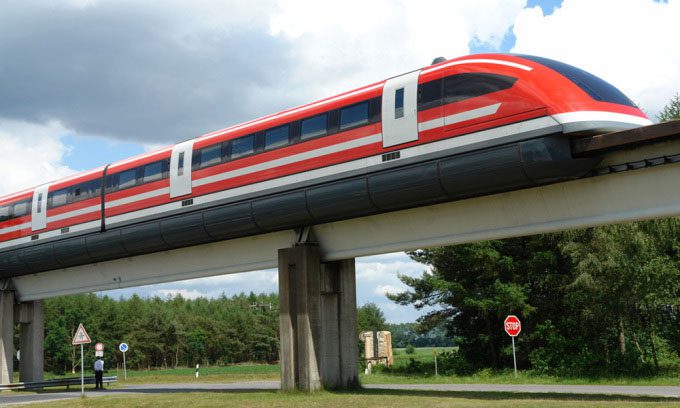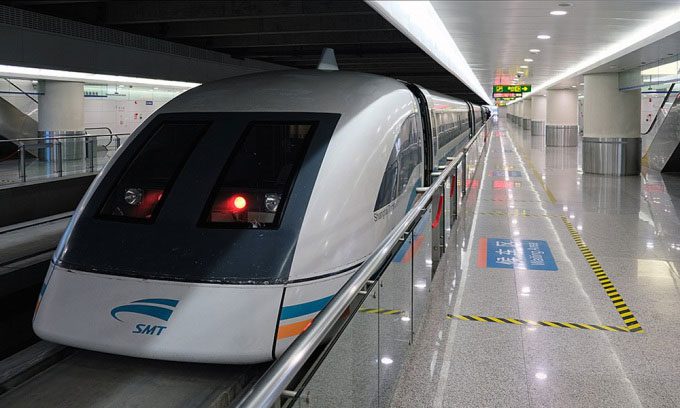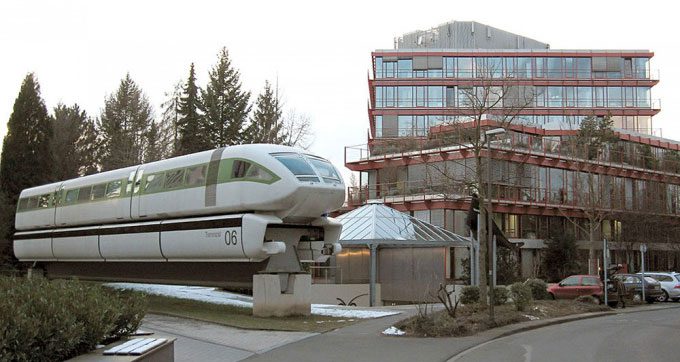Developed since 1969 with advanced magnetic levitation technology, the Transrapid train system has faced numerous challenges in achieving success in Germany, with a tragic accident resulting in 23 fatalities serving as a tipping point.
Transrapid is Germany’s high-speed monorail system that employs magnetic levitation technology (maglev) to hover and propel itself forward. The name Transrapid is derived from a combination of the words transport (to transport) and rapid (fast), emphasizing the system’s goal of providing swift and efficient transportation.

Transrapid 09 at the Emsland test facility in Lower Saxony, Germany. (Photo: Wikimedia).
Using powerful electromagnets, Transrapid’s magnetic levitation technology allows the train to hover above the tracks, reducing friction and enabling very high speeds, which can exceed 500 km/h in some cases.
The Rise and Fall of Transrapid
The first prototypes of the Transrapid system began development in 1969. By 1987, a test facility was established in Emsland, Germany. In 1988, experts planned to construct a maglev track network in Germany, starting with the Hamburg – Hanover line. In 1991, Deutsche Bundesbahn, in collaboration with several prestigious universities, declared the system technically ready.
In 2002, the system was first put into commercial operation with the Shanghai Maglev Train, which runs on Shanghai’s rapid transit network covering approximately 30.5 km to Shanghai Pudong International Airport.
However, no intercity routes utilizing the Transrapid system were operational at that time. Transrapid International, a joint venture between Siemens and ThyssenKrupp, was responsible for the system’s development and marketing.
In Germany, the Emsland test track (the first version of Transrapid) was closed in 2011 when its operating license expired. The demolition and repurposing of the entire Emsland area, including the facility, was approved in early 2012. In September 2017, some proposals suggested using the final version of Transrapid, Transrapid 09, as a conference space and museum at the Fleischwarenfabrik Kemper site.

Transrapid SMT in Shanghai. (Photo: Kallerna/Wikimedia).
How Does Transrapid Work?
The Transrapid system achieves a levitating state by using strong electromagnets in both the train and the track. As the train passes over the magnets, an electric current generates a magnetic field that lifts the train approximately 10 mm above the track.
To move forward, Transrapid employs a linear motor, a type of electric motor that produces linear motion rather than rotational motion like traditional electric motors. The stator (stationary part) of the linear motor is installed along the track, while the rotor (moving part) is attached to the train. When electric current is applied to the stator, it creates a magnetic field that interacts with the magnets on the train, pushing or pulling the train along the track. This enables the train to achieve high speeds and smooth acceleration and deceleration.
Transrapid also incorporates an advanced control system to ensure safety and efficiency. Sensors monitor the train’s position, speed, and other indicators in real-time, adjusting the power supplied to the electromagnets and linear motor as needed. This ensures that the train maintains a stable distance from the track, controlling acceleration, deceleration, and cruising speed for a smooth ride.
Why Did Transrapid Fail?
Transrapid achieved some successes, including exports to China and Australia. However, in Germany and Europe, the system never truly succeeded. Despite the apparent advantages of magnetic levitation technology, Transrapid faced numerous challenges that limited its success, ultimately leading to its decline.
The first barrier was the high development and infrastructure construction costs, primarily due to the special requirements of magnetic levitation technology, such as specialized tracks and complex control systems. The high costs made it difficult to secure funding for new projects, both domestically and internationally.
Political issues also posed a barrier to Transrapid’s success. In Germany, the project faced opposition from various interest groups, concerns about environmental impacts, and issues related to land acquisition. Difficulties and delays in the decision-making process further hindered the system’s implementation.
Competition from traditional high-speed rail systems such as Germany’s ICE and France’s TGV also affected the adoption of Transrapid. These systems offer comparable speed and efficiency, while the construction and maintenance costs are generally lower. As a result, they became more attractive options for investors and authorities.
Moreover, residents living near the train routes also expressed concerns about noise and vibrations. Although the technology reduces noise from wheel-rail contact, magnetic levitation still generates noise due to aerodynamic effects at high speeds.

Transrapid 06 at Deutsches Bonn Museum. (Photo: Rainer Zenz/Wikimedia)
Accidents also contributed to the failure of Transrapid. Typically, two maglev trains cannot collide because two trains on the same track must travel in the same direction at the same speed. However, on September 22, 2006, a Transrapid train on the test track in Lathen, Germany, collided with a maintenance vehicle on the tracks. Emergency brakes helped the train decelerate from 450 km/h to 162 km/h. However, with 34 people on board, that speed was still not slow enough.
The collision destroyed the front part of the train, sending the maintenance vehicle off the track, flipping twice before landing. This was the first serious accident involving a Transrapid train, resulting in 23 fatalities and several serious injuries. The accident was attributed to human error, as the train was allowed to leave the station before the maintenance vehicle had cleared the tracks.
Another incident occurred on August 11, 2006, when a Transrapid train operating on the Shanghai Maglev line caught fire. Shanghai firefighters quickly extinguished the flames. Reports suggested that a battery on the train might have caused the fire.
Finally, the global financial crisis of 2007-2008 and the subsequent economic downturn made it increasingly difficult to secure funding for new Transrapid projects. During this period, investors and authorities became more cautious about investing in expensive infrastructure projects, diminishing Transrapid’s prospects for expansion.




















































